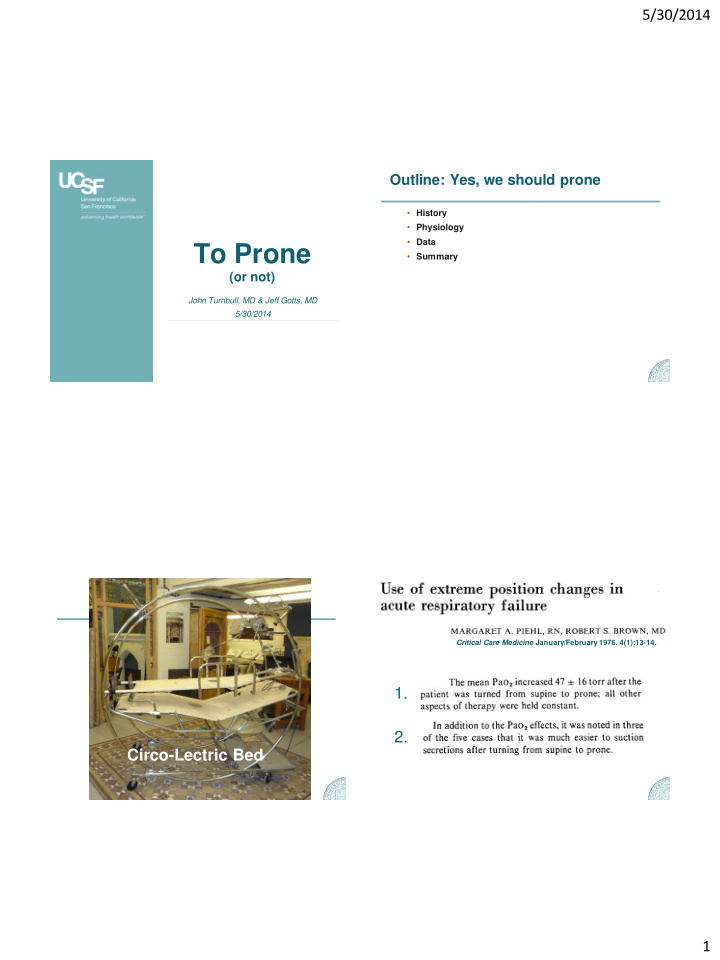



5/30/2014 Outline: Yes, we should prone • History • Physiology • Data To Prone • Summary (or not) John Turnbull, MD & Jeff Gotts, MD 5/30/2014 Critical Care Medicine January/February 1976. 4(1):13-14 . 1. 2. Circo-Lectric Bed 1
5/30/2014 Proning in ARDS: History Anesthesiology . 1991;74(1):15-23. • Early papers had little impact on the critical care community • Mid 1980s: CT scans of patients with ARDS showed extensive areas of dorsal consolidation; compliance proportional to ventral aerated lung “baby lung” • Late 1980s, proning to redistribute blood to this small ventral aerated lung, and oxygenation improved. • Model changed by an important study in 1991 No Gravity Add in Gravity Proning in ARDS: Physiology Lung’s Natural Adapts to Thorax Shape SUPINE • Blood flow distribution does not change much • Oxygenation improves because recruitment/aeration of perfused dorsal lung > ventral de-recruitment • More even distribution of transpulmonary pressure – May improve PEEP’s ability to recruit without hyperinflation • Cardiac compression, lymphatic drainage improved • Secretions drain from dorsal lung toward trachea (less PRONE contamination of healthy lung) Gattinoni L, Taccone P, Carlesso E, Marini JJ. Prone position in acute respiratory distress syndrome. Rationale, indications, and limits. Am J Respir Crit Care Med . 2013;188(11):1286-1293. 2
5/30/2014 Proning in ARDS: Clinical Trials Proning in ARDS: Proseva/Guerin • 466 ARDS patients (<36 hrs) P/F <150 on 0.6/5, 27 prone- experienced ICUs • Strict 6 cc/kg, prone positioning >16 consectutive hrs (avg 17); 91% prone group paralyzed vs. 82% supine • Primary outcome: 28 day mortality Proning in ARDS: Proseva/Guerin Proning in ARDS: Outlier study? • Secondary outcomes: 90 day mortality (21% vs. 41%, NNT 6), more cardiac arrests in supine group, no difference ICU LOS • Better oxygenation, more VFDs in prone group 3
5/30/2014 Beitler JR, Shaefi S, Montesi SB, et al. Prone positioning reduces Beitler JR, Shaefi S, Montesi SB, et al. Prone positioning reduces mortality from acute respiratory distress syndrome in the low tidal mortality from acute respiratory distress syndrome in the low tidal volume era: a meta-analysis. Intensive Care Med . 2014;40(3):332- volume era: a meta-analysis. Intensive Care Med . 2014;40(3):332- 341. 341. Summary • Prone ventilation for ARDS has been used for over 30 years; many centers are expert in the technique • It has a solid physiologic rationale • Strong clinical data now support early proning in patients with severe ARDS – In centers experienced with proning patients – When strictly compliant with low tidal volume ventilation – And encouragement of early use of paralytics 4
5/30/2014 5
5/30/2014 What we really need is an Anti-Gravity Device 6
Recommend
More recommend